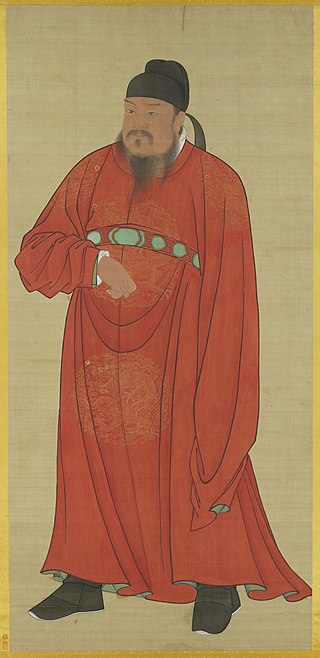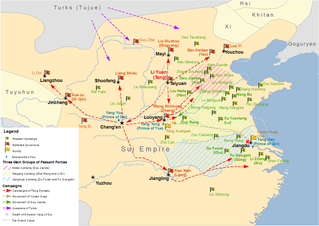Related Research Articles
December 14 is the 348th day of the year in the Gregorian calendar; 17 days remain until the end of the year.
The 610s decade ran from January 1, 610, to December 31, 619.

Year 618 (DCXVIII) was a common year starting on Sunday of the Julian calendar. The denomination 618 for this year has been used since the early medieval period, when the Anno Domini calendar era became the prevalent method in Europe for naming years.

The Kingdom of Sedang was an ephemeral political entity established in the latter part of the 19th century by a French adventurer, Charles-Marie David de Mayréna, in part of what is present-day Vietnam.

The Six Steeds of Zhao Mausoleum are six Tang (618-907) Chinese stone reliefs of horses which were located in the Zhao Mausoleum, Shaanxi, China. Zhao Mausoleum is the mausoleum of Emperor Taizong of Tang.

Xue is the pinyin romanization of the Chinese surname 薛 (Xuē). It is romanized as Hsüeh in Wade-Giles. In Hong Kong and Macau it is usually romanized through its Cantonese pronunciation Sit. In Korean, it corresponds to Seol (설), in Japanese to Setsu and in Vietnamese to Tiết. in Indonesia and Netherlands, it is commonly spelled as Siek. According to the 2010 Chinese Census, it is the 76th most common surname in China, a sharp decline from 48th in 1982. In a study by geneticist Yuan Yida on the distribution of Chinese surnames, people who carry the name Xue are dispersed throughout the country and is most heavily concentrated in Shanxi. It is the 68th name on the Hundred Family Surnames poem.

Emperor Gaozu of Tang was the founding emperor of the Tang dynasty of China, reigning from 618 to 626. Under the Sui dynasty, Li Yuan was the governor in the area of modern-day Shanxi, and was based in Taiyuan.

The Bahnaric languages are a group of about thirty Austroasiatic languages spoken by about 700,000 people in Vietnam, Cambodia, and Laos. Paul Sidwell notes that Austroasiatic/Mon–Khmer languages are lexically more similar to Bahnaric and Katuic languages the closer they are geographically, independently of which branch of the family they belong to, but that Bahnaric and Katuic do not have any shared innovations that would suggest that together they form a branch of the Austroasiatic family, rather forming separate branches.
Empress Ju was an empress of the short-lived state of Qin at the end of the Chinese dynasty Sui Dynasty. Her husband was the state's founder Xue Ju.
Xue Rengao, also known as Xue Renguo (薛仁果), was an emperor of the short-lived state of Qin, established by his father Xue Ju at the end of the Chinese Sui dynasty. Xue Rengao was regarded as a fierce general but overly cruel, and he was only emperor for three months before he was forced to surrender to the Tang dynasty general Li Shimin and was executed.
Li Gui, courtesy name Chuze (處則), was the emperor of a short-lived state of Liang, which he established at the end of the Chinese Sui Dynasty. He governed the parts of modern Gansu west of the Yellow River. In 618, he briefly considered submitting to Emperor Gaozu of Tang, with whom they both believed he had a distant family relationship, but ultimately rejected the idea. In 619, the Tang Dynasty official An Xinggui (安興貴) pretended to submit to him, and then started an uprising at his capital Wuwei, overthrowing him and turning him over to Emperor Gaozu, who executed him.

The transition from Sui to Tang (613–628) was the period of Chinese history between the end of the Sui dynasty and the start of the Tang dynasty. The Sui dynasty's territories were carved into a handful of short-lived states by its officials, generals, and agrarian rebel leaders. A process of elimination and annexation followed that ultimately culminated in the consolidation of the Tang dynasty by the former Sui general Li Yuan. Near the end of the Sui, Li Yuan installed the puppet child emperor Yang You. Li later executed Yang and proclaimed himself emperor of the new Tang dynasty.
Liu Wenjing (568–619), courtesy name Zhaoren, formally the Duke of Lu, was a Chinese politician during the Tang dynasty. He initially served as an official of the Sui dynasty and was one of the driving forces in persuading the general Li Yuan to rebel against Emperor Yang of Sui. He assisted Li Yuan in establishing the Tang dynasty and becoming its first ruler. After Li Yuan became the emperor, he did not award the same honours to Liu Wenjing as he did to Pei Ji, thus Liu became very resentful. He engaged sorcerers to help him seek divine favours, but was executed after Li Yuan found out about it.
Dou Kang, courtesy name Daosheng, was an official and general during the Sui and Tang dynasties who briefly served as a chancellor early in the reign of Emperor Gaozu of Tang.

Du Ruhui (585–630), courtesy name Keming, posthumously known as Duke Cheng of Lai, was a Chinese official who served as a chancellor under Emperor Taizong in the early Tang dynasty. He and his colleague, Fang Xuanling, were often described as role models for chancellors in imperial China.

Marie-Charles David de Mayréna was an eccentric French adventurer who became the self-styled king of the Sedang of the northern Central Highlands in what is now southern Vietnam.
The Bahnar language or Ba-Na language is a Central Bahnaric language. It has nine vowel qualities and phonemic vowel length.
Duan, Doan, or Halang Doan, is a language spoken by more than four thousand people on either side of the Laotian–Vietnamese border. There are some 2,346 speakers in Attopu Province, Laos, and another couple of thousand in Kon Tum Province, Vietnam. It is too poorly known to classify completely and may be mutually intelligible with Takua, Kayong, Halang, and Rengao. Might be a part of the Xơ Ɖăng ethnic group.

The Battle of Qianshuiyuan, northwest of present-day Changwu, Shaanxi, was fought in 618 between the Tang Dynasty and the state of Qin. The battle ended in victory for the Tang, whose armed forces were led by the future emperor Li Shimin.

Initiating Prosperity is a Chinese historical television series based on events in a period in Chinese history known as the Transition from the Sui dynasty to the Tang dynasty. The series was directed by Wang Wenjie and starred Shen Xiaohai, Liu Wenzhi, Zhang Zijian, Sun Feifei and Bao Guo'an. It was first broadcast on television stations in China in 2006.
References
- ↑ Rengao at Ethnologue (18th ed., 2015) (subscription required)